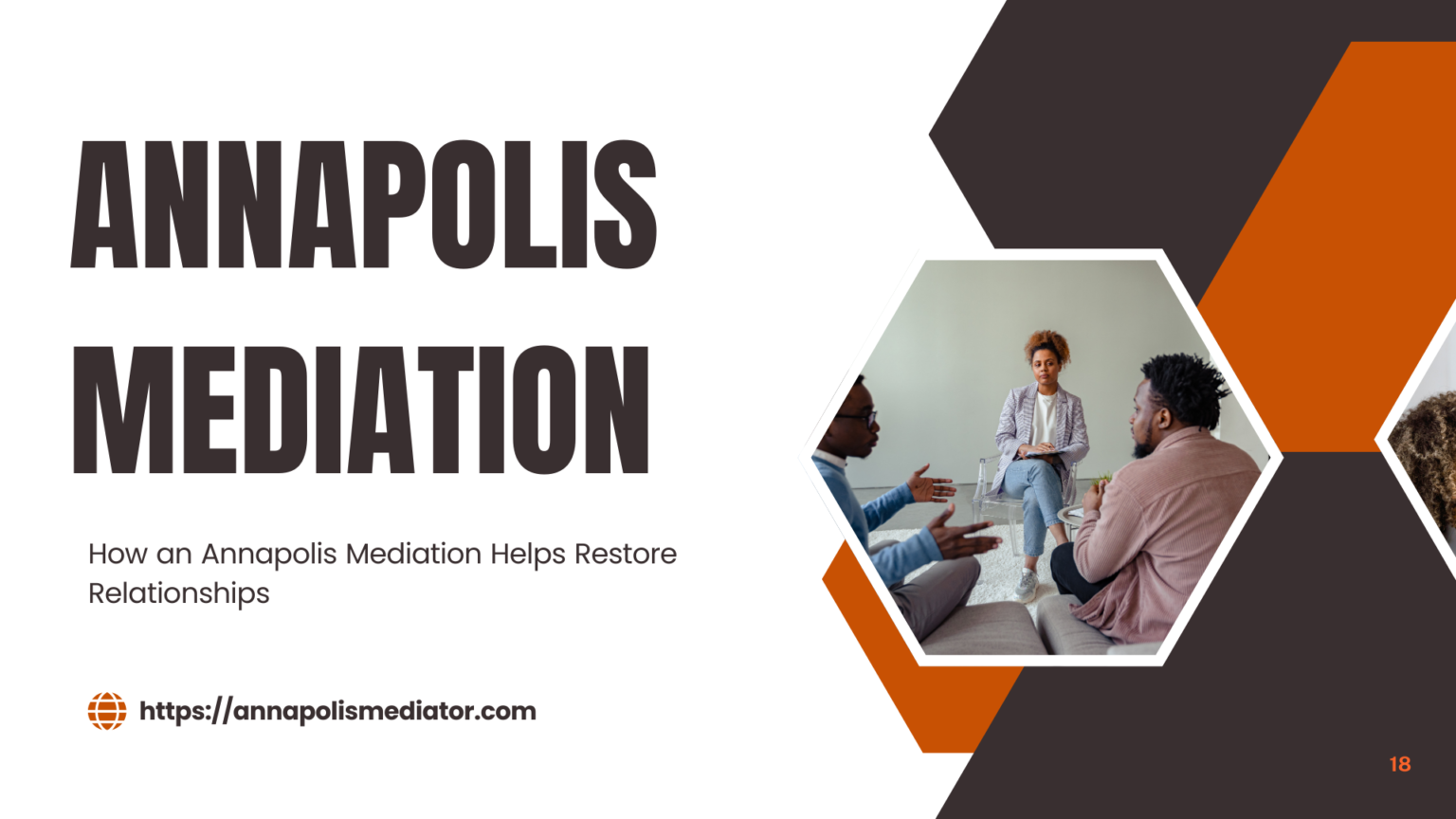Annapolis Mediation: A Solution for Workplace Conflicts
Workplace conflicts are an inevitable part of any professional environment. Whether it’s a disagreement between colleagues, a dispute between employees and management, or a conflict over job responsibilities, tension in the workplace can quickly escalate if not properly addressed. Unresolved conflicts can lead to decreased productivity, higher employee turnover, and a toxic work environment. Fortunately, mediation offers a structured and effective approach to resolving workplace disputes. This article will explore how Annapolis mediation can be a solution for resolving workplace conflicts, promoting a healthier and more productive work environment.
What is Mediation?
Mediation is a voluntary process in which a neutral third party (the mediator) helps the parties involved in a dispute to communicate, understand each other’s perspectives, and work towards a mutually agreeable resolution. The mediator does not have the authority to make decisions or impose solutions. Instead, their role is to facilitate dialogue, identify underlying issues, and encourage compromise.
In the context of the workplace, mediation can be an invaluable tool for resolving disputes between employees, management, and teams. Unlike litigation or formal grievance procedures, mediation focuses on open communication, fostering cooperation, and finding practical solutions that benefit everyone involved.
Why Workplace Mediation Matters
Workplace disputes are common and can arise for various reasons, such as miscommunication, differing work styles, personality clashes, or disagreements over policies. These issues can escalate quickly, affecting not only the individuals involved but also the entire organization. When conflicts are left unresolved, they can lead to:
- Reduced Productivity: Disputes can distract employees from their tasks, causing delays and impacting overall productivity.
- Low Morale: Employees involved in conflicts may feel frustrated or disillusioned, leading to low morale and disengagement.
- Toxic Work Environment: Prolonged unresolved disputes can create a negative work atmosphere, affecting the well-being of all employees.
- High Turnover: If conflicts persist, employees may choose to leave the company, resulting in higher turnover and recruitment costs.
Workplace mediation in Annapolis offers a solution to these challenges by addressing conflicts early on and promoting effective communication. Through mediation, parties involved in a dispute can work together to find a resolution that benefits everyone, avoiding the long-term consequences of unresolved conflicts.
How Does Annapolis Workplace Mediation Work?
Workplace mediation in Annapolis follows a structured process that helps resolve conflicts through constructive dialogue. While each mediation session may vary based on the specific issues and participants, the general process includes the following steps:
1. Preparation
Before the mediation begins, the mediator will typically meet with each party separately. These pre-mediation sessions are designed to understand the underlying issues, gather information, and set expectations for the process. The mediator may also discuss the ground rules for respectful communication and confidentiality.
2. Initial Joint Session
Once the mediator has gathered sufficient information, the mediation process typically begins with an initial joint session. During this session, the mediator introduces the participants, explains the mediation process, and sets the tone for a respectful and open discussion. Each party is given the opportunity to present their perspective on the issue at hand.
3. Identification of Issues
After the opening statements, the mediator will help identify the specific issues causing the conflict. This step is crucial in ensuring that all parties understand the root causes of the dispute and can focus on addressing them constructively.
4. Exploration of Solutions
Once the issues have been clarified, the mediator will guide the discussion towards finding potential solutions. The mediator encourages all parties to brainstorm possible resolutions and evaluate the pros and cons of each option. The goal is to find a solution that is fair, workable, and acceptable to all involved.
5. Negotiation
After exploring potential solutions, the parties will begin negotiating terms that address the identified issues. The mediator helps facilitate the negotiation process by ensuring that each party is heard, and guiding the conversation toward a mutually agreeable outcome. Compromise may be necessary, but the mediator’s role is to keep the discussion focused on resolving the conflict rather than escalating it.
6. Agreement and Documentation
Once a solution has been reached, the mediator will help the parties document the agreement in writing. This document outlines the terms of the resolution and serves as a reference for future interactions. While mediation agreements are not legally binding, they represent a commitment by all parties to honor the agreed-upon solution.
7. Follow-Up
In some cases, the mediator may schedule a follow-up session to ensure that the resolution is being implemented and that no further conflicts have arisen. This step is important for reinforcing the commitment to the agreement and addressing any ongoing issues that may require additional attention.
Benefits of Workplace Mediation in Annapolis
Workplace mediation in Annapolis offers numerous advantages for both employees and employers. The benefits extend beyond simply resolving the current conflict and can have a long-lasting positive impact on the organization as a whole.
1. Cost-Effective Solution
Mediation is typically more cost-effective than litigation or formal grievance procedures. Legal battles can be expensive, and the longer a dispute drags on, the more resources it consumes. Mediation, on the other hand, is a relatively low-cost process that can help resolve conflicts quickly and efficiently.
2. Faster Resolution
Unlike formal legal proceedings, mediation can often be completed in a matter of days or weeks, depending on the complexity of the issues. This quick resolution minimizes disruption to the workplace and allows employees to return to their regular duties without prolonged distractions.
3. Improved Communication and Collaboration
Mediation encourages open communication and collaboration between the parties involved. Through guided discussions, employees learn how to express their concerns respectfully and listen to others’ perspectives. This improved communication can foster better relationships and prevent future conflicts.
4. Restored Relationships
One of the primary goals of workplace mediation is to restore relationships between conflicting parties. By addressing the root causes of the dispute and finding a mutually agreeable resolution, mediation helps repair damaged relationships and creates a foundation for future cooperation.
5. Confidentiality
Mediation is a confidential process, meaning that the discussions that take place during mediation cannot be used in future legal proceedings. This confidentiality encourages open and honest dialogue and ensures that sensitive issues are dealt with privately.
6. Empowerment of Employees
Mediation empowers employees by giving them a voice in the resolution process. Unlike litigation, where decisions are made by a judge or jury, mediation allows employees to actively participate in finding a solution. This sense of involvement and agency can help restore trust and motivation.
When to Consider Workplace Mediation in Annapolis
Workplace mediation is an ideal solution for a variety of conflict scenarios, including:
- Disputes Between Colleagues: When disagreements arise between coworkers, mediation can help resolve the issue without creating a hostile work environment.
- Employee and Management Conflicts: If there are ongoing issues between employees and management regarding workplace policies or decisions, mediation can facilitate a productive dialogue.
- Team Conflicts: Mediation can help teams overcome internal conflicts and improve collaboration.
- Harassment or Discrimination Complaints: Mediation can be used to address complaints of harassment or discrimination in a way that allows for resolution while maintaining confidentiality.
If any of these situations are affecting your workplace, it may be time to consider mediation as a solution.
Conclusion
Annapolis mediation offers a powerful and effective solution for resolving workplace conflicts. By fostering open communication, mutual understanding, and collaboration, mediation promotes a positive and productive work environment. Whether you are facing a conflict between colleagues, management, or teams, mediation provides a cost-effective and timely way to address disputes and restore relationships.
If you are looking for professional mediation services in Annapolis, look no further than Susan Saunders. With her extensive experience in conflict resolution, Susan helps businesses and individuals navigate challenging situations and find peaceful solutions. Her empathetic approach and expertise in mediation ensure that conflicts are resolved in a way that benefits all parties involved. Contact Susan Saunders today to get started on the path to resolving your workplace disputes.


